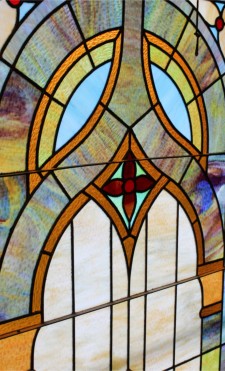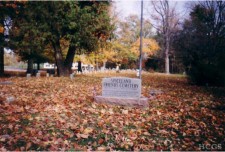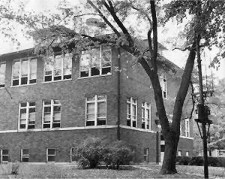Our Beginnings
Spiceland Friends has a long history — dating back to the early 1820s. A number of members of the Religious Society of Friends — many from North Carolina — were responsible for settling the area shortly after the New Purchase Treaty went into effect in 1821. They quickly set up a Friends Meeting and named both the Meeting and the town — Spiceland — after the many spice bushes found growing in the area.
Over the years, the Meeting has gone by various names, although the official name is Spiceland Monthly Meeting of the Religious Society of Friends, or Spiceland Friends Meeting. Today it is often referred to as Spiceland Friends Church.
 Our Meeting House (Church) and Subsequent Additions
Our Meeting House (Church) and Subsequent Additions
The first meeting house was a log structure and was erected in 1828. Before this, Friends worshipped in a log barn, and at least for its first meeting, under the trees in 1824.
In 1833, a framed one-story meeting house replaced the log structure. In accordance with the Society's strict adherence to custom (such as using "thee" and "thou"), the frame meeting house had separate entrances for men and women. Today's Italianate brick meeting house was built just north of the frame building in 1874, fifty years after Friends had first worshiped under the trees on the meeting house grounds. The new brick meeting house, perhaps reflecting a more progressive generation, had no sliding partition to separate men and women. The building's long windows and elaborate brickwork were carried through in the 1969 addition.
In 2005-2006, the meetinghouse was again enlarged with the addition of a beautiful new Family Center — a large, multi-purpose room with a great kitchen that is used for church dinners and many youth activities. The newest addition also includes a Welcome Center, Sunday School classrooms, and church offices — all handicap-accessible.
The many beautiful stained glass windows were all added in 1929. The large stained glass window depicting Christ in the Garden of Gethsemane is especially beautiful.
Spiceland Friends Cemetery
 The first burial in the Friends' cemetery across the street was in 1829, and the last interment was in 1937. At the time when the cemetery was established (in the 1800s), Spiceland Friends reserved a portion of the cemetery grounds for hitching racks for members' horses and buggies. Of the 575 graves in the Friends burial grounds, 200 of them are unmarked. Many early Friends made it a practice to not use a traditional gravestone to mark their graves. Wooden markers or simple field stones were often used to mark graves, and sometimes Friends would choose to have no type of marker on their graves.
The first burial in the Friends' cemetery across the street was in 1829, and the last interment was in 1937. At the time when the cemetery was established (in the 1800s), Spiceland Friends reserved a portion of the cemetery grounds for hitching racks for members' horses and buggies. Of the 575 graves in the Friends burial grounds, 200 of them are unmarked. Many early Friends made it a practice to not use a traditional gravestone to mark their graves. Wooden markers or simple field stones were often used to mark graves, and sometimes Friends would choose to have no type of marker on their graves.
In the far northwest corner of this cemetery is located the grave of a Native American Indian. Old-timers say that for many years the spot was marked by a lone pine tree. Spiceland's cholera victims from the 1839 epidemic are buried here. Benjamin and Joseph Hunt (brothers) were two victims with gravestones. Twelve to fifteen others are buried in one long row. This cemetery contains the last resting place of a veteran of the War of 1812, several former slaves, and thirteen Civil War soldiers.
Spiceland Academy
 While America was concerned with the Civil War and the fight over slavery, Friends at Spiceland had another concern — the education of their children. They had worked against slavery as no other one group of people had, but they also wanted adequate school facilities for their children. In 1870, Friends opened the Spiceland Academy, which continued to meet the educational needs for many students far beyond the confines of the Meeting, until it closed in 1921.
While America was concerned with the Civil War and the fight over slavery, Friends at Spiceland had another concern — the education of their children. They had worked against slavery as no other one group of people had, but they also wanted adequate school facilities for their children. In 1870, Friends opened the Spiceland Academy, which continued to meet the educational needs for many students far beyond the confines of the Meeting, until it closed in 1921.
During the 1873-1874 school years, there were students who attended the Academy from Ohio, Illinois, Kansas, Kentucky, the Indian Territories, the Sandwich Islands (Hawaii), as well as from several Indiana counties. The Academy must have had something special to offer to draw students from such a wide radius. There are reports that state that at one time 50% of the school teachers in Henry County were trained at the Academy.
The Academy sat on land adjacent to the meeting house, and the Meeting continues to own that land today.
Known for Serving Others
Spiceland Friends Meeting has always promoted mission work — locally, nationally, and internationally. Notable examples have been the support of Friends American Indian mission centers in Oklahoma, Iowa, and Alabama; White's Residential and Family Services (formerly known as White's Institute) located in Wabash, Indiana; and our Quaker brethren in Kenya, East Africa. Locally, we also respond when needs arise in our county, and especially our school corporation. We support a wide variety of missions and charitable organizations on a regular basis. To learn more, check out our Missions page on this website.

